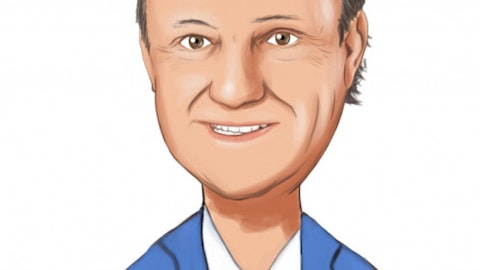Jill Timm: In terms of omnichannel, what I would say is, obviously, digital is always an incremental pressure when it does come to that cost of ship. We are seeing, obviously, for a cost, like we mentioned, moderating, so not seeing as much of an increase there that we have in the past. But it will always as we increase that penetration of digital be a headwind. I think so, if you heard today, we think there’s substantial opportunity to grow our store productivity. And so that is definitely a place that helps us offset some of those headwinds because the penetration won’t be growing as much if we can grow both channels. And I think that’s something we’ve heard a lot about. Our focus is how do we bring back the productivity into our stores, and whether that’s through presentation changes, through the new categories that Tom has mentioned and really just the focus to drive in new customers through initiatives such as Sephora.
So, I think we see it as always an extra headwind, but it isn’t quite as predominant as it’s been in the past. And I think the third piece of it is we’re also seeing a lot more efficiency out of our new fulfillment centers. And they — as we continue to put more products through those centers, we are getting more efficient to how we can get it to the customer. And then, of course, we continue to utilize our stores, which gets us with — in a couple of days of our customers as well. So we’re able to do that in a really efficient manner. So our stores continue to play a key role in our digital delivery, which actually makes our inventory even work harder. So as we talk about that inventory discipline and turning inventory, that’s another lever that we can utilize as well.
So, I look at — we have a huge opportunity to grow stores, which will help us kind of mitigate some of the headwinds we’ve seen on the cost of shipping side in the past.
Operator: Our next question comes from Oliver Chen at TD Cowen.
Oliver Chen: Regarding what’s the new strategy, I had a bigger picture question is the younger customer and capturing the traffic of the younger customer, women’s apparel, in particular, has been an opportunity. And would love your thoughts on — as you think about home and gifting, what percentage mix do you see as an opportunity or a hypothesis there? And as we think about gross margin, return on inventory, will the terms and margin profile differ? And I assume the opportunity will outweigh any of those factors. Jill, I would love your thoughts on inventory control processes and what specifically do you see as lower-hanging fruit. And as we think about this inflation and inflation, what does your forecast include in terms of average unit retail? Thank you very much.
Tom Kingsbury: So I’ll take the first part, and then I’ll let Jill take the second piece of this. Well, having Sephora, bringing Sephora in is already bringing in a younger consumer. One of the other things that we’re working on is ancillary products such as women’s, that when the younger customers coming in to buy Sephora, we want to make sure that they can also buy women’s apparel, women’s accessories, women’s footwear, et cetera. So, we really feel that we’re started. We have something that’s bringing in a younger consumer. Now we need to expand it to other categories within the store. As far as the mix goes in terms of what percent, as I just mentioned before, we’re not — we’re going to let the customer tell us what level the mix should be in home décor and gifting. Jill?
Jill Timm: And I think from an inventory control perspective, I just think the processes and the disciplines we have in place in terms of the chase model and really letting ourselves have some liquidity and not making all the buys upfront, like Tom has mentioned is a core fundamental that we just really need to reinstate, instead of allocating all our goods ahead of time. I think this way, we can chase them to the right items. It helps the sell-throughs. It helps the margins because you’re buying the right goods, so you don’t have to take as many marks at the end of season. So I think that’s just really a core discipline that really needs to get reinstilled into the organization. And then quite honestly, the liquidity is going to go where the demand is.
So, even though bustle plants at the beginning of the year, we need to be agile in moving through those based on what the consumer is looking for and then giving that open to buy to the right areas. So I think that’s fundamental I’ve always been really focused, as you know, on inventory control. So I love the new disciplines that Tom has brought to the organization. And then in terms of…
Tom Kingsbury: We’re going to spend — excuse me, just one second. We’re just going to spend and we already have — we’re just going to spend a lot of time on inventory. And that area is going to report directly to me because of the importance that inventory control is in terms of everything we want to accomplish in 2023 and beyond. Sorry Jill.
Jill Timm: No problem. And I think just on the inflation, deflation from an AUR perspective, I think that isn’t anything we saw a lot of inflation in our AURs this year in terms of — we are in a discretionary spend. It wasn’t the same as if you’re buying or selling things people need. So we haven’t been able to really expand on the AUR. Our AUR growth has really been more of the mix of the goods that we’re bringing to the table. And again, it’s all with the lens of value. But you bring in Sephora, obviously, a higher ticket item. It’s something that we’ve seen continually perform for us, despite the ups and downs in the inflationary environment. We’ve brought in different items of products like Tommy Hilfiger and Calvin Klein had had higher tickets.
So, we’re really going to be I think managing through this in a very easy manner because we didn’t bring tickets up. And then 65% of our sales are national brands. So we’re really going to be ticketed based on what those brands are seeing across the landscape and then we’ll move with them as well. So, I think one thing is we didn’t take things up because of inflation. So there’s not a lot of room to have to take things down either from my perspective.
Oliver Chen: Okay. And Tom, one follow-up on making pricing less complex. What’s the timing at which you’ll execute on that? And Kohl’s Cash is pretty iconic and the Company has been on a journey to simplify and amplify, less can be more. So, what’s different about what you think needs to be done? And what kind of guardrails might be good ideas around making these kinds of changes?
Tom Kingsbury: Well, whatever we do, we’re going to be very thoughtful and do everything at the appropriate pace. One of the things that we’re doing, and it will start around the back-to-school period, we’re going to bring in some product that have everyday low prices. It’s small. It’s single digits as a percent to total, and we’re going to learn from that and then determine how big it’s going to be or maybe it won’t be big at all. But it’s in test mode overall. We have a lot of layering of promotions and stuff like that. And we’re just going to try to simplify a lot of that. We’re not going to back off of Kohl’s Cash. That’s a very important component to the value equation overall. But we’re just going to — we’re going to test other things.
We want to focus on spending more markdowns on clearance because as Jill said, we’re going to take clearance at the appropriate time. We want to allocate markdowns monthly to address our clearance inventories, which is really important. We’re going to be more targeted in a lot of our promotions as well. Right now, we have a lot of general promotions, general audience promotions, which we’re going to look at that. We’ve already — we’ve already reviewed the first and second quarter to figure out where we could do that but — and spend more of our markdowns on targeting certain areas where we feel that we have an opportunity. But everything we do, it’s going to be at the right pace.
Operator: And we’ll take our final question from Paul Lejuez at Citi.
Tracy Kogan: Thank, guys. It’s Tracy Kogan filling in for Paul. Just two questions. On CapEx, it looks like you’re reducing your CapEx this year, which is understandable, but just wondering if that’s a good run rate and you’re no longer expecting the $2.5 billion over three years? And then secondly, I was hoping you could update us on the Amazon partnership and how do you assess the traffic driving results of the Amazon Returns in stores and how you’re doing converting as you look back at this year overall? Thanks.





